Pallet Inverter: How Can Breweries Quickly Flip Pallets for Cleaning?
Spilled beer, sticky residue, and general warehouse grime can turn your brewery's pallets into a source of contamination and inefficiency. Manually unloading a full pallet just to clean it or swap it out is a slow, back-breaking job that puts your team at risk and your production schedule behind. This manual process is a hidden cost, eating away at your profits through wasted labor, potential product damage, and the constant risk of workplace injuries. As someone who has spent his life designing and building machinery to solve logistical problems, I've seen this exact issue slow down countless operations. There is a much better way.
A pallet inverter allows breweries to quickly flip pallets for cleaning by mechanically clamping a full pallet of goods, rotating it 180 degrees, and enabling the swift removal and replacement of the original pallet. This automated process secures the entire load, completes the transfer in under a minute, and completely eliminates the need for dangerous and inefficient manual handling.
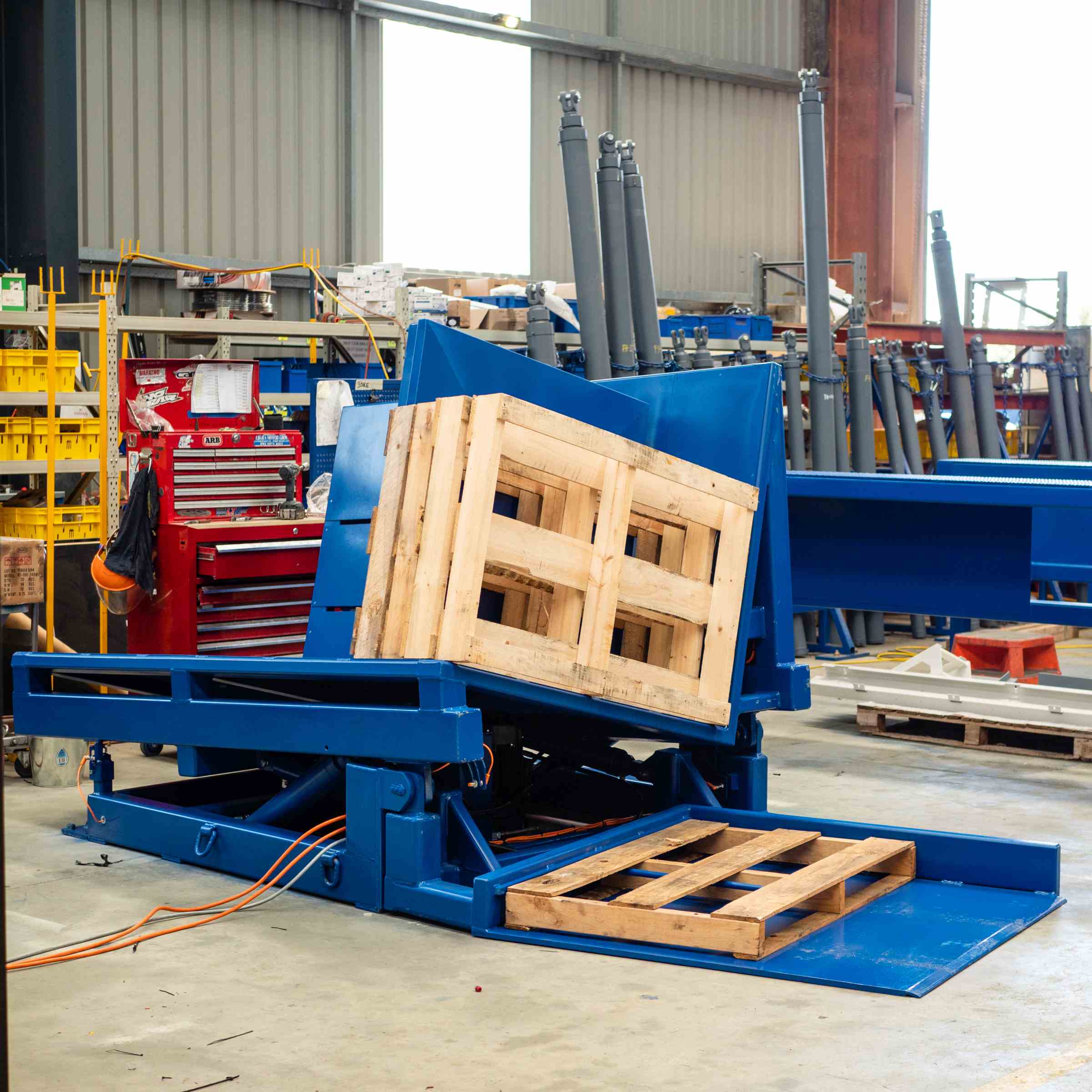
You understand the basic concept, but you're probably wondering how this piece of equipment actually fits into the fast-paced flow of a brewery. It’s one thing to see a picture; it’s another to visualize it on your own floor, handling your specific products. You need to know it's a practical solution, not just a theoretical one. Let's dig deeper into how these machines work in the real world and what makes them a smart investment for your business.
How does a pallet inverter actually work in a brewery setting?
I know the thought of introducing a new machine into your established workflow can be daunting. You worry about creating bottlenecks, the time it takes to train your team, and whether it can handle your specific loads, from kegs to fragile cases of bottles. You wonder if the machine will cause more problems than it solves. I've helped many clients integrate new equipment, and I can tell you that a modern pallet inverter is designed to be surprisingly simple and seamless. Let me walk you through exactly how it works on the floor.
In a brewery, a pallet inverter works when a forklift operator places a full, dirty pallet directly into the machine's loading bay. The machine then uses adjustable hydraulic pressure to gently but firmly clamp the load from the top and sides, securing everything in place. It then rotates the entire load 180 degrees. This places the product stack upside-down on the machine's other platform, which now holds a new, clean pallet. The old, dirty pallet is now on top, easily removed by the forklift for cleaning or disposal.
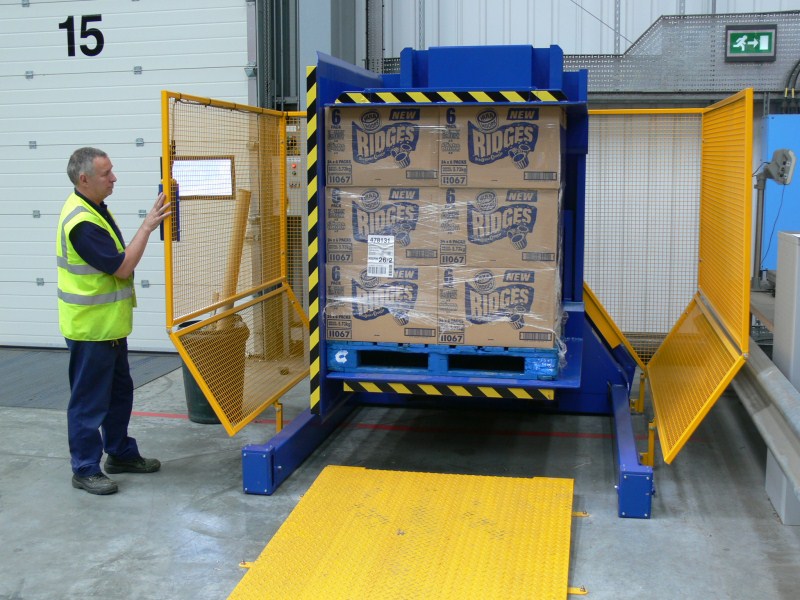
The Step-by-Step Workflow
Let's break down the process into simple, actionable steps. This isn't complex engineering; it's a practical workflow that your team can master quickly.
- Loading: A standard forklift drives a full pallet of goods—let's say cases of your flagship IPA—into the inverter's open bay. The machine is floor-level, so there's no need for special ramps or pits.
- Clamping: The operator, using a simple control panel, initiates the clamping sequence. Two padded walls move in from the sides, and a top platform lowers to secure the load. The pressure is pre-set to be strong enough to hold everything securely but gentle enough not to crush the cardboard boxes or glass bottles inside.
- Inverting: The operator presses the 'rotate' button. The entire clamped load smoothly rotates 180 degrees. The whole process is quiet and controlled, taking about 30-45 seconds.
- Pallet Exchange: The machine opens. The original, dirty pallet is now sitting on top of the inverted stack of beer cases. The forklift driver simply lifts it off. Another forklift can then place a clean pallet on the load before the machine rotates back, or the load can be picked up directly from the inverter's platform.
- Unloading: The clean, newly palletized load is now ready. The forklift removes it and takes it to its next destination, whether that's storage, shipping, or the production line.
Handling Different Brewery Loads
Breweries don't just move one type of product. You have stacked cases of bottles, wrapped cans, and heavy, awkwardly shaped kegs. A good pallet inverter is designed for this variety.
- Cases and Cans: For boxed or shrink-wrapped goods, the side clamps and top press provide even pressure distribution, keeping the stack stable.
- Kegs: For palletized kegs, the clamping system securely holds the entire unit. This is far safer than trying to move individual, heavy kegs by hand. The machine does all the heavy lifting.
To really see the difference, let's compare the old way with the new way.
| Task | Manual Pallet Swap | Pallet Inverter Method |
|---|---|---|
| Labor Required | 2-3 Workers | 1 Forklift Operator |
| Time Taken | 15-30 Minutes | < 2 Minutes |
| Safety Risk | High (lifting, bending, trips) | Very Low (operator stays in cab) |
| Product Damage Risk | Moderate (dropped boxes, spills) | Minimal (load is always secure) |
| Space Required | Large area for restacking | Compact machine footprint |
As you can see, it's not just about speed. It's about safety, protecting your product, and using your labor more effectively.
What are the key safety features to look for in a pallet inverter?
Bringing a powerful piece of machinery onto your brewery floor naturally raises questions about safety. The last thing any of us wants is an accident. An unsafe machine is a liability that can lead to severe injuries, damaged product, and costly shutdowns. I've built my career on the principle that machinery must be both efficient and safe. When you look at a pallet inverter, you are not just buying a function; you are investing in a safe process.
Key safety features to look for in a pallet inverter include a complete safety enclosure, such as physical fencing with interlocked gates or light curtains that immediately stop the machine if an object or person crosses the beam. Also, look for dual-chain or hydraulic lifting mechanisms for redundancy, easily accessible emergency stop buttons, and, crucially for a brewery, adjustable clamping pressure to prevent crushing fragile goods like glass bottles.
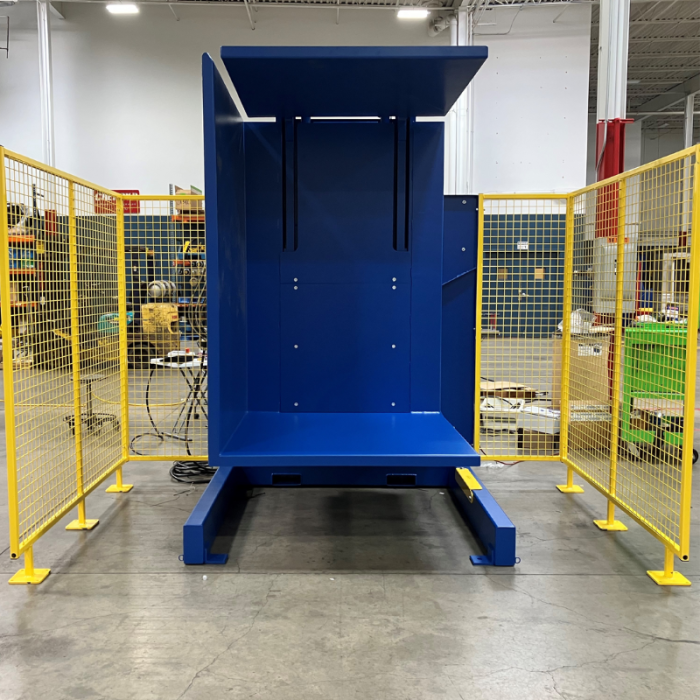
Active vs. Passive Safety Systems
When we talk about safety, we can break it down into two types: passive and active systems. Both are critical.
- Passive Safety: This includes the physical construction of the machine. A heavy-duty steel frame is a must. It ensures the machine remains stable under the full weight of a load of kegs or bottles. It also includes physical guards and barriers that prevent accidental contact with moving parts. These are always "on" and don't require any action from the operator.
- Active Safety: These are systems that actively monitor the machine's environment. The most common are light curtains. These project invisible beams of infrared light across the machine's entrance. If a person, forklift, or any object breaks that beam while the machine is in motion, it instantly stops the cycle. This prevents anyone from walking into the machine's operational area. Another active feature is the interlocked gate. If you choose a model with a full safety fence, the gate will have a sensor. The machine cannot start if the gate is open, and the gate cannot be opened until the machine has completed its cycle and is in a safe position.
The Critical Role of Clamping Pressure
For a brewery, this might be the most important feature of all. Your products are often fragile. Crushing a pallet of your finest craft beer is a costly mistake. A quality pallet inverter must have adjustable clamping pressure. The operator should be able to set the pressure based on the load. A pallet of sturdy kegs can handle more pressure than a stack of cardboard cases filled with glass bottles. The control system should be precise, allowing you to find that perfect balance: firm enough to hold the load securely during rotation, but gentle enough to leave every single bottle unharmed.
Let's look at a simple checklist you can use when evaluating a machine.
| Safety Feature | Description | Why It's Critical for a Brewery |
|---|---|---|
| Safety Fencing/Light Curtains | Creates a protective barrier around the machine. | Prevents workers from accidentally walking into the path of a rotating, heavy load. |
| Emergency Stop Buttons | Large, accessible buttons that immediately cut all power. | Allows for an instant halt in any unforeseen situation. |
| Adjustable Clamping Pressure | Allows the operator to set the force applied to the load. | Protects fragile items like glass bottles and packaging from being crushed. |
| Dual Hydraulic/Chain System | Redundant lifting mechanisms provide a fail-safe. | If one system fails, the other prevents the load from falling, preventing a major accident. |
| Pressure Relief Valve | Prevents the hydraulic system from over-pressurizing. | Protects both the machine's components and the product being handled. |
How can a pallet inverter improve overall warehouse efficiency beyond just cleaning?
You might be looking at a pallet inverter and thinking it’s a single-task machine, a niche solution only for swapping dirty pallets. I understand that thinking. It's hard to justify a significant investment if it only solves one small problem. But in my experience building solutions for industries from steel to food and beverage, the best equipment is versatile. It solves multiple problems. A pallet inverter is a perfect example of a tool that can boost your entire warehouse operation, not just your cleaning routine.
Beyond pallet cleaning, a pallet inverter drastically improves warehouse efficiency by enabling the quick transfer of goods from standard wooden pallets to hygienic plastic pallets for cleanroom environments, or to cheaper slip sheets for shipping. It is also essential for recovering damaged goods from the bottom of a stack without manually destacking the entire pallet. This versatility reduces labor, accelerates order fulfillment, and minimizes product waste across your operation.
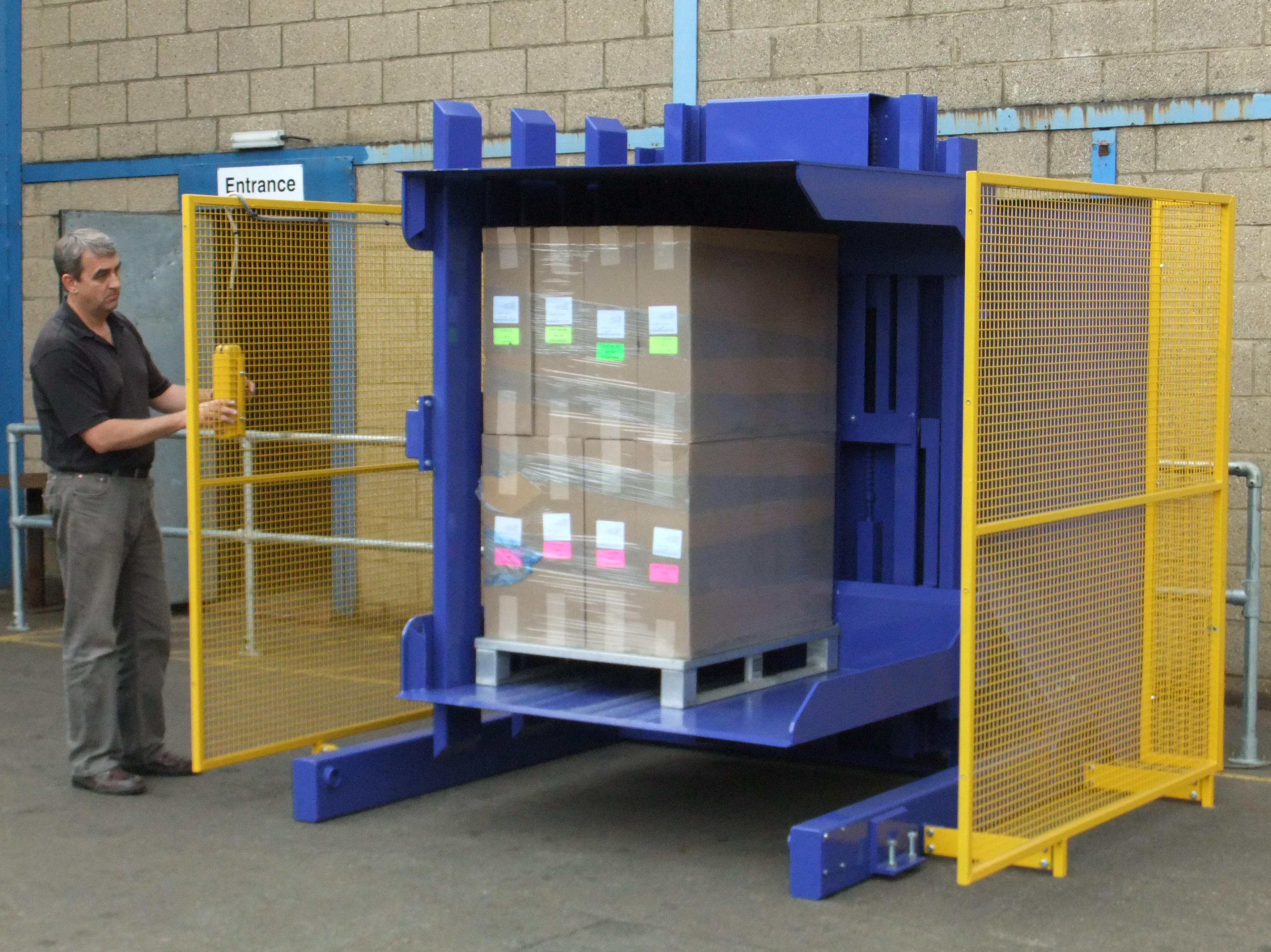
From In-House Pallets to Shipping Pallets
Many breweries use high-quality, durable pallets for internal use. But when it comes to shipping, you may want to switch to a different type.
- Cost Savings: You can transfer finished goods from your expensive in-house pallets to cheaper, one-way shipping pallets or even slip sheets, which can dramatically reduce freight costs. You keep your quality pallets within your facility.
- International Shipping: If you export your beer, you know about ISPM 15 regulations, which require heat-treated or plastic pallets. An inverter allows you to quickly and easily switch your product to compliant pallets just before loading a container, avoiding delays and potential fines.
- Customer Requirements: Some large retailers or distributors require products to arrive on their specific pool pallets (like CHEP or PECO). An inverter makes this transfer process a simple, one-person job.
The "Damage Recovery" Lifesaver
Imagine this scenario: a forklift driver notices that the bottom case on a full pallet of bottled beer has been crushed, or the pallet itself is broken and unstable. What's the usual process? A team of workers has to manually unstack the entire pallet, box by box, just to get to the one damaged case at the bottom. This is slow, risky, and inefficient.
With a pallet inverter, this problem is solved in two minutes. The operator inverts the entire load, removes the broken pallet and the damaged case from the top, and inverts it back onto a new pallet. What was once a 30-minute, multi-person headache is now a quick, safe, one-person fix. You save the rest of the pallet from potential collapse, reduce labor costs, and get the product back into circulation immediately.
| Application | Description | Impact on Warehouse Efficiency |
|---|---|---|
| Pallet Swapping | Transfer goods from one pallet type to another (e.g., wood to plastic). | Reduces pallet costs, meets shipping regulations, satisfies customer needs. |
| Damage Recovery | Access and replace broken pallets or damaged goods at the bottom of a stack. | Saves product, eliminates hours of manual restacking, improves safety. |
| Load Straightening | Re-center a load that has shifted during transport or handling. | Prevents stack collapse in racking, improves storage density and safety. |
| Freezer Spacer Removal | In food applications, quickly remove freezer spacers from frozen goods. | Dramatically speeds up the tempering process before shipping. |
This machine isn't a one-trick pony. It's a logistics multi-tool that addresses several common warehouse bottlenecks.
What is the ROI of investing in a pallet inverter for a brewery?
As a business owner or manager, every decision comes down to the bottom line. "How much does it cost?" is always followed by, "When do I get my money back?" You cannot afford to invest in equipment that doesn't provide a clear, measurable return. Vague promises of "efficiency" are not enough; you need to see the numbers. From my years of helping factories justify investments, I know that calculating the Return on Investment (ROI) for a pallet inverter is a straightforward exercise based on tangible cost savings.
The ROI of a pallet inverter is calculated by comparing the initial investment against the combined annual savings in labor costs, reduced product damage, lower pallet rental or purchase fees, and increased throughput. Most breweries and beverage facilities find that the machine pays for itself within 12 to 24 months, depending on the volume of pallets they handle.
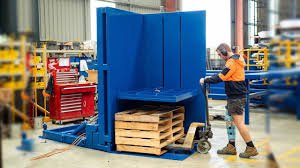
Breaking Down the Savings
Let's look at the specific areas where you will see a financial return. This isn't theoretical; this is real money that goes back into your budget.
1. Labor Cost Savings
This is the most direct and easiest saving to calculate.
- Manual Method: Swapping a pallet takes 2 workers about 20 minutes (0.33 hours).
- Inverter Method: Swapping a pallet takes 1 worker about 2 minutes (0.033 hours).
Let's assume an average labor rate of $25/hour (including benefits).
- Manual Cost per Swap: 2 workers 0.33 hours $25/hour = $16.50
- Inverter Cost per Swap: 1 worker 0.033 hours $25/hour = $0.83
- Savings per Swap: $15.67
If your brewery swaps just 10 pallets per day, your daily savings are $156.70. Over a 250-day work year, that's $39,175 in direct labor savings alone.
2. Reduced Product Damage
Manual handling leads to dropped boxes and broken bottles. It's a fact of life. Let's be conservative and say you lose an average of $30 worth of product each week from handling accidents during pallet swaps. That's $1,560 per year. A pallet inverter secures the load, virtually eliminating this type of damage. You can add that $1,560 directly to your ROI calculation.
3. Pallet Cost Optimization
If you use a pallet rental service like CHEP, you pay for every pallet that leaves your facility. By using an inverter to switch to cheaper one-way pallets for shipping, you can drastically cut these rental fees. The savings can be thousands of dollars per year, depending on your shipping volume.
A Sample ROI Calculation
Let's put it all together in a simple table. The cost of a pallet inverter can vary, but let's use a realistic figure for our example.
| Cost/Saving Category | Calculation / Assumption | Annual Value |
|---|---|---|
| Total Investment Cost | Pallet Inverter + Installation | ($60,000) |
| Annual Labor Savings | $15.67/swap 10 swaps/day 250 days | $39,175 |
| Annual Product Damage Savings | $30/week * 52 weeks | $1,560 |
| Pallet Fleet Savings | Reduced rental fees or purchase of cheaper pallets | $5,000 |
| Total Annual Savings | Sum of all savings | $45,735 |
| Payback Period (Months) | Total Investment / (Total Annual Savings / 12) | 15.7 Months |
In this realistic scenario, the machine pays for itself in less than 16 months. After that, it generates over $45,000 in pure profit and operational savings for your brewery every single year.
My Insights: A Lesson from the Steel Industry
You might be reading this about breweries and thinking, "This is interesting, but my world is different." I understand. I built my career in the demanding environment of steel coil and wire packing. On the surface, a brewery and a steel mill seem like opposites. But I've learned that the fundamental challenges of manufacturing and logistics are universal.
A business leader I admire, someone like Javier Morales who built a steel empire from the ground up, understands this. He faces pressure from energy costs, aging equipment, and market demands. He doesn't invest in equipment; he invests in solutions that deliver a clear return—in efficiency, safety, and profitability.
I once worked with a steel wire factory facing a problem very similar to a brewery's pallet issue. They needed to transfer heavy coils of steel wire from their rugged in-house skids to specific, heat-treated skids for international export. The process was done with cranes and manual labor. It was incredibly slow, and worse, it was dangerous. A dropped coil could be catastrophic.
We didn't install a standard pallet inverter, but the principle was identical. We designed a heavy-duty inverter that could handle the immense weight and unique shape of the wire coils. The result was transformative. They reduced the transfer time for a single unit from 45 minutes to just 5 minutes. They completely eliminated a category of back and hand injuries that had plagued that department for years. The machine paid for itself in 18 months, just on labor and safety improvements alone.
The lesson is this: the principle of smart, safe load handling applies everywhere. Whether you are flipping a pallet of fragile beer bottles or a coil of steel, the goal is the same. You need to move your product from point A to point B quickly, safely, and cost-effectively. A pallet inverter isn't just a "brewery machine" or a "steel machine." It is a fundamental tool for modern logistics that solves a universal problem.
Conclusion
A pallet inverter is more than a cleaning tool. It's a strategic investment in your brewery's safety, efficiency, and profitability, solving multiple logistical challenges with one reliable machine.



